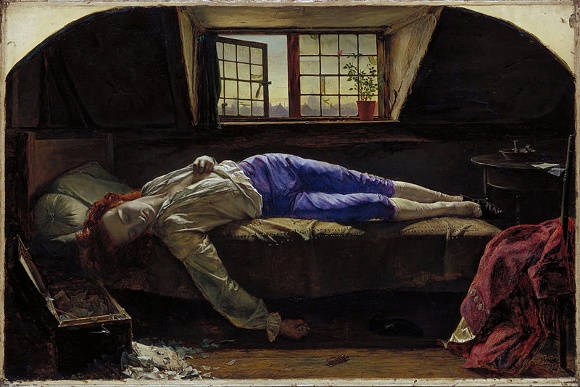John Keats, selected poems Contents
Ode on Indolence: Synopsis and Commentary
Synopsis of Ode on Indolence
In the opening stanza the speaker describes a vision he had one morning. Three figures wearing white robes and sandals passed by him – looking like figures depicted on the surface of a marble urn. When the final figure passed by, the initial ones reappeared, just as if a vase was being turned round.
In the second stanza the speaker addresses the figures and asks how he did not recognise them and why they managed to appear so quietly and so unnoticed. He says that he suspects them of a plot to steal away his ‘idle days’. He continues by describing how he spent the morning before they arrived – by drowsily enjoying a summer’s day, numb to the more painful aspects of life. In the final two lines he asks the figures why they have not disappeared to leave him to his state of ‘nothingness’.
The third stanza sees the figures passing by for a third time and the speaker feels an urge to get up and follow them, as he now knows who they are: Love, Ambition and Poesy (poetry).
In the fourth stanza the figures disappear and once again the speaker longs to follow them. However, he also knows that to do so would be ‘folly’ since none of the figures offers a permanent solution to life’s challenges. Love does not last; Ambition’s existence is even briefer and Poesy cannot compete with the joys of lazy days untroubled by ‘busy common-sense’.
In the fifth stanza the speaker is distressed that the figures have returned and describes again how he had spent the morning before they arrived. Then his soul seemed like a green lawn made beautiful with flowers, shadows and sunbeams. There was no rain and bird song flooded in through an open window. He tells the figures that they were right to leave him as they had failed to rouse his passions.
In the final stanza the speaker says farewell to them and once again declares that neither Love nor Ambition nor Posey is enough to make him raise his indolent head bedded in the ‘flowery grass’. He tells them that he already has plenty of visions. His parting shot is to command them to vanish and never return.
Commentary on Ode on Indolence
On March 19 1819 Keats wrote to George and Georgiana Keats:
The Ode on Indolence was probably written shortly after this time, but was not published until 1848, twenty-seven years after the poet’s death.
Keats’ letters from this period often dwell on the same theme:
… I have been very idle lately, very averse to writing; both from the over-powering idea of our dead poets and from abatement of my love of fame. I hope I am a little more of a Philosopher than I was, consequently a little less of a versifying Pet-lamb … You will judge of my 1819 temper when I tell you that the thing I have most enjoyed this year has been writing an ode to Indolence.
A letter from his brother George had forced Keats to review his personal situation. Poetry was not supplying him with either money or fame; he needed financial security if he was to marry Fanny Brawne. The Ode is one of the few poems Keats wrote which are directly concerned with his own situation. It seems to stem from his own struggle with conflicting impulses: fame, love and poetry on one side, indolence on the other.
 Glossary
Glossary
Motto ‘They toil not, neither do they spin’. This is taken from Jesus’ admonishment to trust in the provision of God in Matthew 6:28-30 ‘Consider the lilies of the field, how they grow; they toil not, neither do they spin.’
one deep in Phydian lore: a reference to Phidias, the great Athenian sculptor of the fifth century B.C., who designed the marble sculptures for the Parthenon (see commentary on On seeing the Elgin Marbles.)
masque: a form of entertainment which consisted of dancing and acting performed by masked players
A third time pass’d they by: Keats may be echoing Macbeth in stanza 3 and it may be a reference to the witches’ prophecies in Act IV of Shakespeare’s play. A more definite Macbeth allusion is suggested in stanza 4: ‘From a man’s little heart’s short fever-fit’ and its similarity to Macbeth Act 3 Scene 2: ‘After life’s fitful fever he sleeps well.’ This may mean that Keats was thinking of Ambition, Love and Poesy as his version of the three witches who tempt Macbeth towards his damnation.
throstle: an archaic term for song thrush
annoy: pain or harm. Keats will have remembered the term from his reading of Spenser’s The Faerie Queene, the poem which above all others first inspired him with the desire to become a poet.
Investigating commentary on Ode of Indolence...
- Explain how this ode is connected to the letter (referred to above) that Keats wrote to George and Georgiana Keats.
- Do you think it is necessary to know the biographical context in order to understand and appreciate the poem?
- What is the significance of the allusion to Macbeth?
- English Standard Version
- King James Version
Recently Viewed
-
John Keats, selected poems » Ode on Indolence: Synopsis and Commentary
now -
John Keats, selected poems » Isabella: or The Pot of Basil: Synopsis and commentary
just now -
A-Z: General definitions » William Shakespeare
just now -
John Keats, selected poems » The relationship between imagination and creativity
just now -
John Keats, selected poems » To Ailsa Rock: Language, tone and structure
just now -
John Keats, selected poems » Isabella: or The Pot of Basil: Language, tone and structure
just now -
John Keats, selected poems » Romanticism
just now
